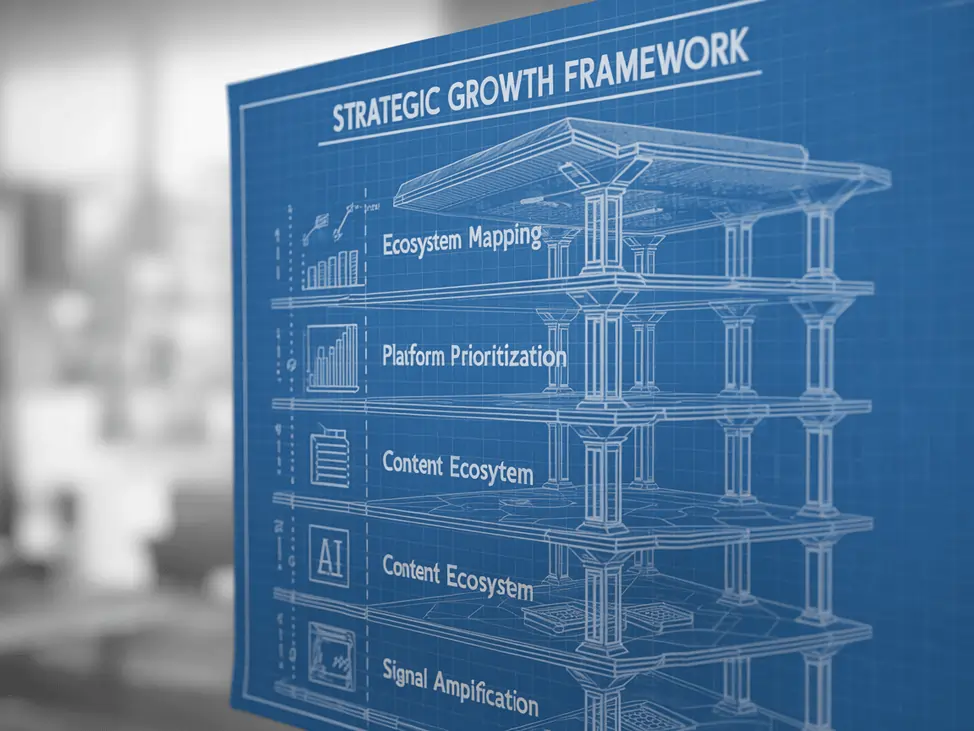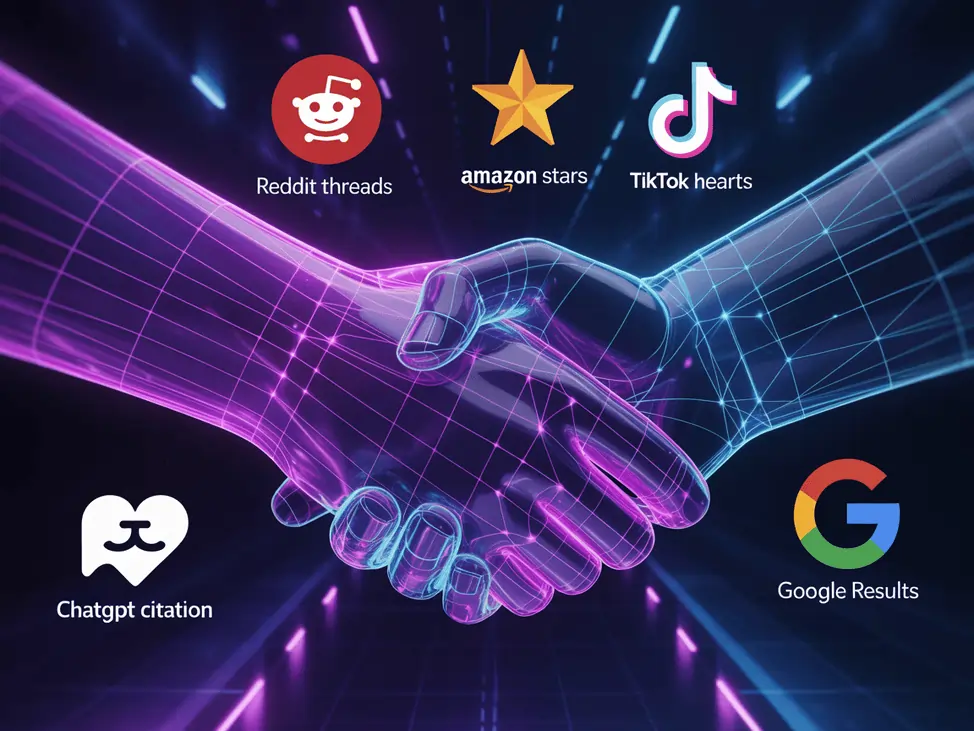Your Customers Aren’t Where You Think They Are
While you’ve been perfecting your Google SEO strategy, your customers have quietly migrated to new decision-making environments. They’re asking ChatGPT for product recommendations, validating purchases through Reddit discussions, discovering brands on TikTok, and making final decisions based on Amazon reviews—often without ever visiting your website. This shift is part of The Multi-Platform Search Revolution: Why Your SEO Strategy Needs to Evolve in 2025.

This shift represents the biggest change in search behavior since Google’s inception, yet most businesses are still optimizing for a single search engine while their customers make decisions across dozens of platforms.
This evolution in search behavior emphasizes the importance of adapting your SEO approach to truly embrace The Multi-Platform Search Revolution: Why Your SEO Strategy Needs to Evolve in 2025.
The Hidden Search Ecosystem Your Business is Missing
Recent data reveals that traditional Google searches represent less than 30% of all search activity online. The remaining 70% happens across what we call the “distributed search ecosystem”:
- Social Discovery: Instagram, TikTok, and LinkedIn for initial awareness
- Validation Searches: Reddit threads, Facebook groups, and community forums
- AI-Powered Queries: ChatGPT, Claude, and other AI assistants providing instant recommendations
- Purchase Research: Amazon reviews, YouTube unboxings, and comparison videos
- Professional Networks: Industry-specific platforms and B2B communities
Each platform serves a unique psychological function in the modern customer journey, yet most businesses treat them as afterthoughts to their “real” SEO strategy.
The Psychology Behind Platform-Specific Search Behavior
Understanding why customers use different platforms for different stages of their decision process is crucial for developing an effective multi-platform strategy:
Emotional Discovery Phase
Platforms: TikTok, Instagram, Pinterest Psychology: Users seek inspiration and emotional connection Content Strategy: Visual storytelling, behind-the-scenes content, lifestyle integration
Rational Evaluation Phase
Platforms: YouTube, LinkedIn, industry blogs Psychology: Users want detailed analysis and expert opinions Content Strategy: Educational content, case studies, thought leadership
Social Validation Phase
Platforms: Reddit, Facebook groups, review sites Psychology: Users seek authentic peer experiences and unbiased opinions Content Strategy: Community engagement, user-generated content, transparent communication
AI-Assisted Decision Phase
Platforms: ChatGPT, Claude, search assistants Psychology: Users want quick, authoritative answers with minimal effort Content Strategy: Structured data, comprehensive resources, citation-worthy content
Final Purchase Phase
Platforms: Amazon, e-commerce sites, app stores Psychology: Users need social proof and risk reduction Content Strategy: Review optimization, detailed specifications, clear value propositions
Building Your Multi-Platform Search Architecture

Successful multi-platform optimization requires a systematic approach that complements, rather than replaces, your existing SEO efforts.
Phase 1: Search Ecosystem Mapping
Identify where your customers actually spend time during their decision-making process. This isn’t about demographic data—it’s about behavioral mapping:
- Survey recent customers about their research process
- Analyze referral traffic patterns in your analytics
- Monitor brand mentions across all platforms
- Track competitor presence and engagement
Phase 2: Platform Prioritization Matrix
Not all platforms deserve equal attention. Use this evaluation framework:
Business Impact Potential (1-10): How much revenue could this platform generate? Audience Alignment (1-10): How well does the platform’s user base match your target market? Content Fit (1-10): How naturally does your content work on this platform? Resource Requirements (1-10): How much effort is needed to succeed here? (Lower scores = more resources needed)
Focus on the 2-3 platforms with the highest combined scores.
Phase 3: Content Ecosystem Development
Create platform-native content that serves each stage of the customer journey:
Authority Content: Long-form educational pieces for YouTube and LinkedIn Community Content: Discussion-starting posts for Reddit and Facebook groups Discovery Content: Visually engaging posts for Instagram and TikTok Reference Content: Comprehensive guides that AI can cite and reference
Phase 4: Cross-Platform Signal Amplification
The real power comes from creating connections between platforms:
- Reddit discussions that reference your YouTube videos
- AI responses that cite your comprehensive guides
- Amazon reviews that mention your social media presence
- Google results that show diverse platform coverage
The Trust Signal Revolution
Traditional SEO focused on technical signals—backlinks, page speed, keyword density. Multi-platform optimization focuses on trust signals—mentions, citations, reviews, and authentic engagement.
These trust signals compound across platforms:
- A mention in a popular Reddit thread gets indexed by Google
- An AI citation reinforces your authority everywhere
- A viral TikTok drives Amazon review volume
- Positive reviews influence social media discovery
Measuring Success Beyond Traditional Metrics
Multi-platform search success requires new measurement approaches:
Brand Mention Velocity
Track how often your brand gets mentioned across all platforms, not just linked to from websites.
AI Citation Rate
Monitor how frequently AI assistants reference your brand when users ask relevant questions.
Cross-Platform Journey Analysis
Understand how customers move between platforms during their decision process.
Trust Signal Density
Measure the volume and sentiment of authentic mentions, reviews, and discussions about your brand.
Platform-Specific Conversion Attribution
Track which platforms drive actual business results, not just traffic.
Common Multi-Platform Optimization Mistakes
Mistake #1: Using the same content across all platforms Solution: Create platform-native content that matches user expectations and algorithms
Mistake #2: Treating social platforms as broadcasting channels Solution: Engage authentically in community discussions and provide value first
Mistake #3: Ignoring AI optimization Solution: Structure content for AI consumption with clear, factual information and proper citations
Mistake #4: Focusing only on owned media Solution: Invest in earning mentions and citations on platforms you don’t control
Mistake #5: Measuring vanity metrics instead of business impact Solution: Track platform-specific conversions and customer journey data
The Competitive Advantage Window
Most businesses are still optimizing for yesterday’s search landscape. They’re perfecting Google SEO while ignoring the platforms where their customers are actually making decisions.
This creates a massive opportunity for forward-thinking companies to capture market share by meeting customers where they are, not where businesses wish they were.
The window for this competitive advantage is closing as more companies recognize the shift. Early adopters will establish trust signals and community presence that become increasingly difficult for competitors to replicate.
Your Next Steps
Week 1: Audit your current multi-platform presence and identify gaps Week 2: Survey customers about their actual research and decision process
Week 3: Choose 2-3 priority platforms based on customer behavior and business potential Week 4: Develop platform-specific content strategies that complement your SEO efforts
The future belongs to businesses that understand search as an ecosystem, not a single platform. While your competitors perfect their Google rankings, you can capture the majority of search activity happening everywhere else.
Ready to Expand Beyond Traditional SEO?
At PiXENDA, we specialize in developing comprehensive multi-platform search strategies that capture customers throughout their entire decision journey. Our team understands the unique psychology of each platform and how to create content that drives real business results.
We don’t just manage your social media—we architect your presence across the entire search ecosystem to ensure your brand appears where and when your customers are making decisions.
Contact PiXENDA today to discover how multi-platform search optimization can multiply your current SEO results and capture the 70% of search activity your competitors are missing.
Let’s build your search presence for the way customers actually behave, not the way we wish they did.

